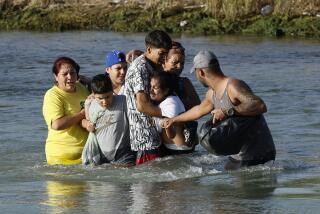Old Span in Keys Is a Bridge Too Far for Cuban Refugees
MIAMI — Within sight of the Florida Keys, the Cubans’ homemade boat had sprung a bad leak and was in danger of sinking. So its 15 passengers, who risked their lives crossing the Florida Straits, could make it no farther than an old and abandoned bridge.
Had they reached the United States? The refugees, who clustered on the bridge’s concrete pilings between Marathon and Little Duck Key early on the morning of Jan. 5, may have believed so. But the Coast Guard, which rescued the Cubans, ruled they hadn’t -- the section of the Old Seven Mile Bridge where the refugees disembarked was no longer connected to land.
After consulting with government legal specialists, the Coast Guard on Monday sent the Cubans back to Cuba.
It is a case that has angered members of Florida’s Cuban American community and led to demands from elected officials that the Bush administration change what is commonly known as the “wet-foot, dry-foot” policy for dealing with Cuban migrants.
The policy, in effect since 1995, generally mandates that Cubans fleeing the regime of Fidel Castro who are interdicted at sea will be returned home, while those who make it to U.S. soil will be allowed to stay.
But what happened to the recent boatload of Cubans, said some Cuban American leaders, was inhumane legal hairsplitting that condemned a group of would-be immigrants to life under a communist dictatorship.
“Because they reached an old bridge and not a new bridge, there’s a judgment they didn’t reach American soil?” Sen. Mel Martinez (R-Fla.) questioned in a statement. “The semantics used to return these men and women -- who have risked so much to reach freedom and are now returned to an uncertain future -- are an embarrassment.”
Three Cuban American lawmakers from South Florida sent a letter to the State Department and Department of Homeland Security asking for a new policy so that all Cuban migrants, including those at sea, would be granted access to a lawyer before a ruling was made on whether to allow them entry into the United States.
“We have witnessed a record number of human trafficking cases from Cuba, a dramatic increase of Cuban nationals attempting to flee the island, an extraordinary amount of refugees repatriated without regard for the merits of their asylum petitions, and basically, an overall process that constitutes an embarrassment to the United States,” Reps. Lincoln Diaz-Balart, Mario Diaz-Balart and Ileana Ros-Lehtinen, all Republicans, wrote in the letter.
Two days after the nine men, four women and two children were sent back to Cuba, two Bush administration officials -- Stephen McFarland, director of the State Department’s Office on Cuban Affairs, and Cuba Transmission Coordinator Caleb McCarry -- heard demands for a change in the immigration policy at a lunch with Cuban American community leaders.
In the view of the legal specialists consulted by the Coast Guard, the abandoned bridge section did not meet the definition of “dry-foot” because the Cubans couldn’t have walked from there to U.S. soil, said Angela McArdle, a spokeswoman at Coast Guard headquarters in Washington.
“For purposes of comparison, it’s the same as if it were a buoy anchored to the bottom of the sea, or a vessel anchored at sea,” McArdle said. “Part of what’s tricky is that there’s always going to be a border, always a line. And according to our policy, migrants have to reach shore or be taken ashore on dry land. This was not the case.”
The spokeswoman declined to speak about the specifics of the case because relatives of the Cubans sued Homeland Security Secretary Michael Chertoff to permit their entry. But, she said, the Coast Guard had done nothing more than apply the law as interpreted by its legal experts in Washington.
“The Coast Guard doesn’t set immigration policy,” McArdle said. “We enforce it.”
The Old Seven Mile Bridge was built from 1909 to 1912 over a channel between the Florida Straits and Gulf of Mexico, and was originally a railroad bridge before being converted for use on the Overseas Highway, the stretch of U.S. 1 that links the Florida Keys with the mainland.
The old bridge, which was used as a set for scenes in the 1994 action movie “True Lies,” was replaced by a parallel span in the 1980s. A swing span on the old bridge that permitted the passage of boats was dismantled, effectively cutting a section off from land, said Dennis Fernandez, assistant district structures and facilities engineer with the Florida Department of Transportation. That was where the Cubans landed.
The new Seven Mile Bridge, which does connect to land on both ends, is 400 feet away, but it would be difficult for people arriving on a boat to find a place to climb onto it, Fernandez said.
At the Freedom Tower, a Miami landmark where many Cuban exiles were processed after Fidel Castro took power in 1959, Cuban American activist Ramon Saul Sanchez is on a hunger strike. Speaking by cellphone Friday afternoon, Sanchez said he was in the seventh day of his fast in an effort to pressure the Bush administration to review the “wet foot-dry foot” policy. Sanchez is president of the Democracy Movement, an anti-Castro group.
“Many, many people are coming by here to express their support, not only Cubans, but also Americans, people of all nationalities,” Sanchez said.
“Because it doesn’t make any sense for the U.S. to take the position that to deny people’s rights, they are willing to detach a piece of the country.”
Miami Mayor Manny Diaz said it was time to replace a system of immigration he called “nothing more than the lucky outcome of a race” to reach U.S. territory before being caught.
More to Read
Sign up for Essential California
The most important California stories and recommendations in your inbox every morning.
You may occasionally receive promotional content from the Los Angeles Times.










